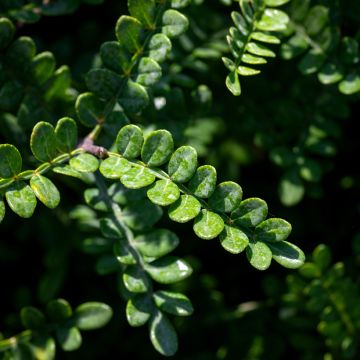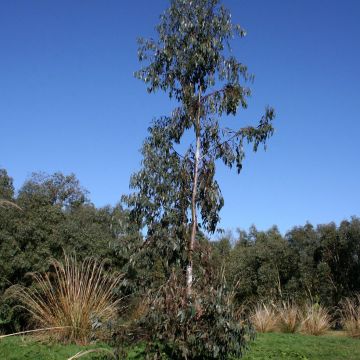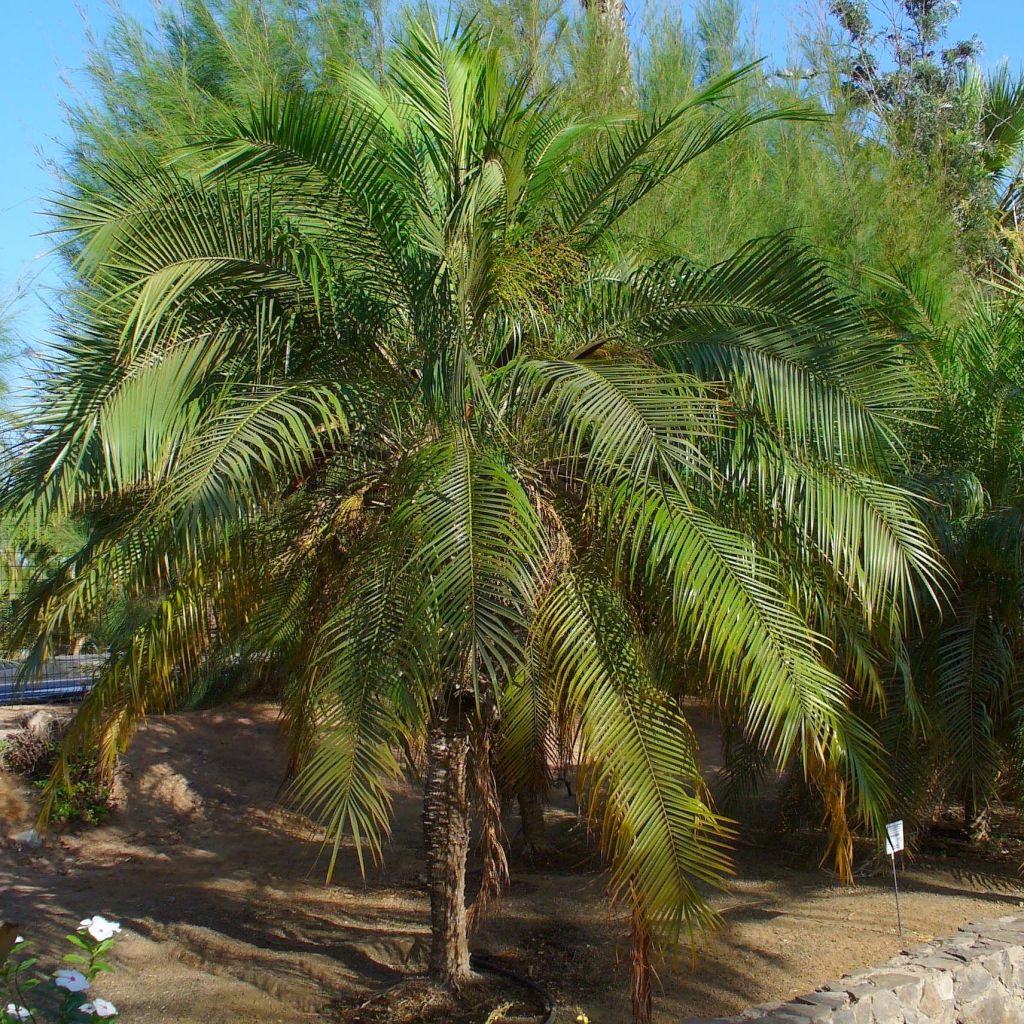

Phoenix roebelinii


Phoenix roebelinii
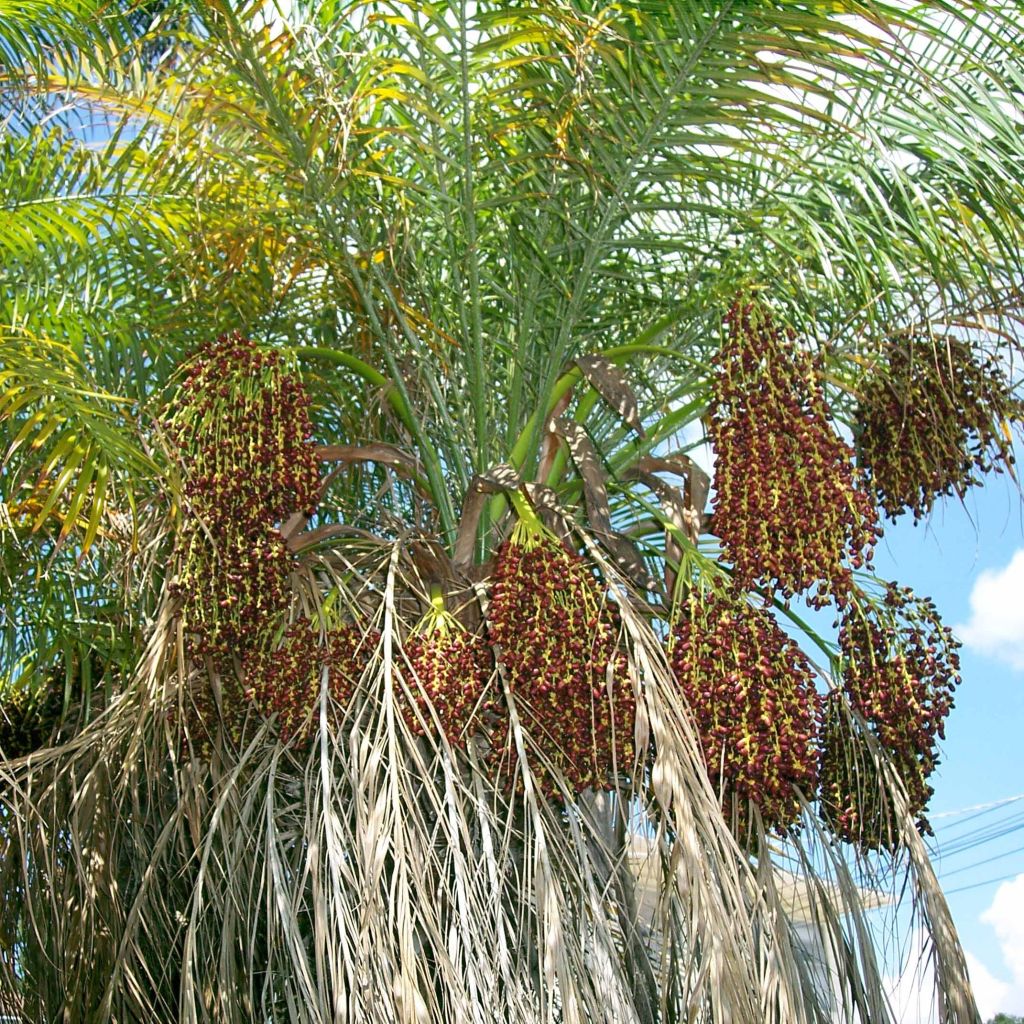

Phoenix roebelinii
Phoenix roebelinii
Phoenix roebelinii
Pygmy Date Palm, Miniature Date Palm
Plant arrived in good condition, very beautiful and of a good size.
Colette, 19/11/2024
This item cannot be shipped to the selected country
Oversize package delivery charge from €6.90
Delivery charge from €5.90
Delivery to Corse prohibited
More information
Schedule delivery date,
and select date in basket
This plant carries a 24 months recovery warranty
More information
We guarantee the quality of our plants for a full growing cycle, and will replace at our expense any plant that fails to recover under normal climatic and planting conditions.
Oversize package: home delivery by special carrier from €6.90 per order..
Express home delivery from €8.90.
From €5.90 for pickup delivery and €6.90 for home delivery
Express home delivery from €8.90.
Delivery to Corse prohibited: UE law prohibits the import of this plant from mainland France to Corse as part of the fight against Xylella fastidiosa. Please accept our sincere apologies.
More information

Does this plant fit my garden?
Set up your Plantfit profile →
Description
The Phoenix roebelinii is without a doubt one of the best indoor palm trees. This cousin of the Date Palm, sometimes called the Mekong Date Palm, is not only extremely graceful, but it is also small in size, and above all it adapts to many growing conditions, forgiving forgotten watering as well as excessive watering, tolerating lack of sunlight and the rather dry atmosphere of our interiors. All these qualities make us forget that it has retained from its tropical origins a chilly temperament that does not cope well with our winters. Installed in a carefully chosen large pot, it will bring a magnificent exotic touch to the living room or the veranda.
The Phoenix roebelinii belongs to the large family of Arecaceae. It is widespread on the banks of the Mekong, from Laos to Thailand, where it grows in periodically flooded areas, but also in drier areas. Its resistance to cold is limited, although the plant can tolerate brief periods at -3 or -4°C (26.6 or 24.8°F). The False Date Palm is an arborescent plant that reaches a height of 4 m (13ft) in its natural habitat. When grown in the ground, it will not exceed 3 m (10ft) in height, and 2 m (1 and 7ft) in a pot.
Its trunk, called a stipe, is solitary, thin, and does not exceed 10 to 15 cm (4 to 6in) in diameter. It is covered with remnants of old petioles surrounded by brown fibers. With age, it becomes bare and more or less smooth. At its top, a gracefully rounded but light crown develops, transparent and composed of large, slender, and arched leaves, measuring 1 to 2 m (3 to 7ft) in length. Each leaf is divided into many narrow, leathery, plicate leaflets, carried by a long spiny petiole. The foliage is bright green in color. The flowering occurs in summer, in the form of dense, white clusters that emerge between the leaves. Female plants produce potentially edible fruits, shaped like small dates measuring 1 cm (1in).
The Phoenix roebelinii is a magnificent houseplant or veranda plant, within the reach of any careful gardener. This palm tree doesn't appreciate being moved, for example from the living room to the terrace or vice versa, or from the greenhouse to the veranda, and it fears transplantations. in areas spared from frost, it will therefore be grown in a container and installed in a bright veranda or in a very bright room, with some direct sunlight. To accompany it, choose for example dwarf banana trees (Musella lasiocarpa) or other indoor palm trees such as Areca and Kentia.
Report an error about the product description
Phoenix roebelinii in pictures


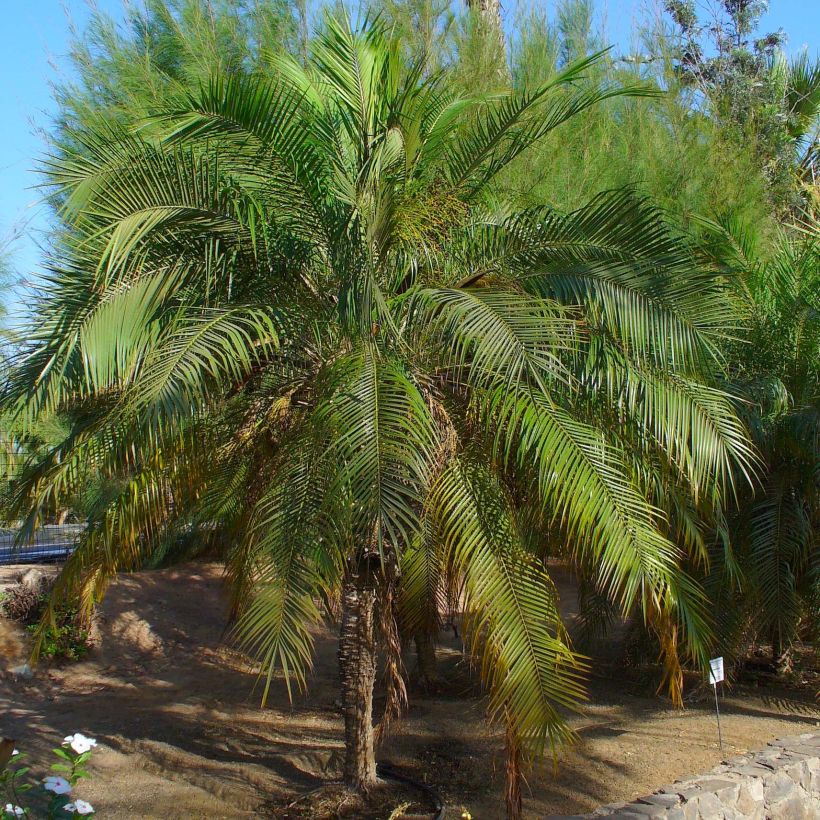

Plant habit
Flowering
Foliage
Botanical data
Phoenix
roebelinii
Arecaceae
Pygmy Date Palm, Miniature Date Palm
India
Other Phoenix
Planting and care
This dwarf date palm is only planted in open ground in our mildest regions of the Mediterranean coastline, as its hardiness does not exceed -3 to -4 °C (26.6 to 24.8°F). Elsewhere, plant it in a large pot and cultivate it indoors, in a very bright and sunny room or in the conservatory. It is a very accommodating species, accepting any type of well-balanced soil, neither too acidic nor too chalky, occasionally waterlogged to dry. It prefers sunny exposures but also performs well in partial shade or even dappled shade. The Mekong Date Palm requires little maintenance apart from pruning the oldest fronds close to the stem.
Pot cultivation:
Choose a very large pot or a perforated bottom container with a capacity of 75 liters. Prepare a mixture composed of 50% loamy soil, 25% compost, and 25% sand. Mix well. Partially fill your container, after placing a drainage layer at the bottom (clay balls, gravel, broken clay pots). Place your palm on the mixture so that the collar (the area where the roots originate) does not protrude from the pot but is not buried too deep either. Add the rest of the mixture around the root ball, firming it down. Water in stages to saturate the substrate with water and remove air. Place your palm in a very bright location with some direct sunlight. Avoid moving it around. Wait for it to acclimatise to the room or conservatory before repotting. Spray the foliage occasionally and reduce watering in winter. It is a hungry plant; provide organic fertilizer or compost in spring and optionally supplement with diluted complete liquid fertilizer for green plants.
Diseases and pests:
In the PACA region, where they are often planted, as well as throughout southern France and Spain, large palm trees are attacked by parasites such as the feared and widespread Paysandra archon caterpillar, a large butterfly that is found as far as England. Specific treatments are now available for preventive purposes. The red palm weevil (Rhynchophorus ferrugineus) has been present in our territory since 2006. Symptoms include fronds being cut, dried, or turning yellow. These pests attack numerous palm species, with a fatal outcome; the leaves irreversibly and completely dry up as soon as the core of the stem harbors larvae.
Planting period
Intended location
Care
-
, onOrder confirmed
Reply from on Promesse de fleurs
Evergreen shrubs
Haven't found what you were looking for?
Hardiness is the lowest winter temperature a plant can endure without suffering serious damage or even dying. However, hardiness is affected by location (a sheltered area, such as a patio), protection (winter cover) and soil type (hardiness is improved by well-drained soil).

Photo Sharing Terms & Conditions
In order to encourage gardeners to interact and share their experiences, Promesse de fleurs offers various media enabling content to be uploaded onto its Site - in particular via the ‘Photo sharing’ module.
The User agrees to refrain from:
- Posting any content that is illegal, prejudicial, insulting, racist, inciteful to hatred, revisionist, contrary to public decency, that infringes on privacy or on the privacy rights of third parties, in particular the publicity rights of persons and goods, intellectual property rights, or the right to privacy.
- Submitting content on behalf of a third party;
- Impersonate the identity of a third party and/or publish any personal information about a third party;
In general, the User undertakes to refrain from any unethical behaviour.
All Content (in particular text, comments, files, images, photos, videos, creative works, etc.), which may be subject to property or intellectual property rights, image or other private rights, shall remain the property of the User, subject to the limited rights granted by the terms of the licence granted by Promesse de fleurs as stated below. Users are at liberty to publish or not to publish such Content on the Site, notably via the ‘Photo Sharing’ facility, and accept that this Content shall be made public and freely accessible, notably on the Internet.
Users further acknowledge, undertake to have ,and guarantee that they hold all necessary rights and permissions to publish such material on the Site, in particular with regard to the legislation in force pertaining to any privacy, property, intellectual property, image, or contractual rights, or rights of any other nature. By publishing such Content on the Site, Users acknowledge accepting full liability as publishers of the Content within the meaning of the law, and grant Promesse de fleurs, free of charge, an inclusive, worldwide licence for the said Content for the entire duration of its publication, including all reproduction, representation, up/downloading, displaying, performing, transmission, and storage rights.
Users also grant permission for their name to be linked to the Content and accept that this link may not always be made available.
By engaging in posting material, Users consent to their Content becoming automatically accessible on the Internet, in particular on other sites and/or blogs and/or web pages of the Promesse de fleurs site, including in particular social pages and the Promesse de fleurs catalogue.
Users may secure the removal of entrusted content free of charge by issuing a simple request via our contact form.
The flowering period indicated on our website applies to countries and regions located in USDA zone 8 (France, the United Kingdom, Ireland, the Netherlands, etc.)
It will vary according to where you live:
- In zones 9 to 10 (Italy, Spain, Greece, etc.), flowering will occur about 2 to 4 weeks earlier.
- In zones 6 to 7 (Germany, Poland, Slovenia, and lower mountainous regions), flowering will be delayed by 2 to 3 weeks.
- In zone 5 (Central Europe, Scandinavia), blooming will be delayed by 3 to 5 weeks.
In temperate climates, pruning of spring-flowering shrubs (forsythia, spireas, etc.) should be done just after flowering.
Pruning of summer-flowering shrubs (Indian Lilac, Perovskia, etc.) can be done in winter or spring.
In cold regions as well as with frost-sensitive plants, avoid pruning too early when severe frosts may still occur.
The planting period indicated on our website applies to countries and regions located in USDA zone 8 (France, United Kingdom, Ireland, Netherlands).
It will vary according to where you live:
- In Mediterranean zones (Marseille, Madrid, Milan, etc.), autumn and winter are the best planting periods.
- In continental zones (Strasbourg, Munich, Vienna, etc.), delay planting by 2 to 3 weeks in spring and bring it forward by 2 to 4 weeks in autumn.
- In mountainous regions (the Alps, Pyrenees, Carpathians, etc.), it is best to plant in late spring (May-June) or late summer (August-September).
The harvesting period indicated on our website applies to countries and regions in USDA zone 8 (France, England, Ireland, the Netherlands).
In colder areas (Scandinavia, Poland, Austria...) fruit and vegetable harvests are likely to be delayed by 3-4 weeks.
In warmer areas (Italy, Spain, Greece, etc.), harvesting will probably take place earlier, depending on weather conditions.
The sowing periods indicated on our website apply to countries and regions within USDA Zone 8 (France, UK, Ireland, Netherlands).
In colder areas (Scandinavia, Poland, Austria...), delay any outdoor sowing by 3-4 weeks, or sow under glass.
In warmer climes (Italy, Spain, Greece, etc.), bring outdoor sowing forward by a few weeks.










































